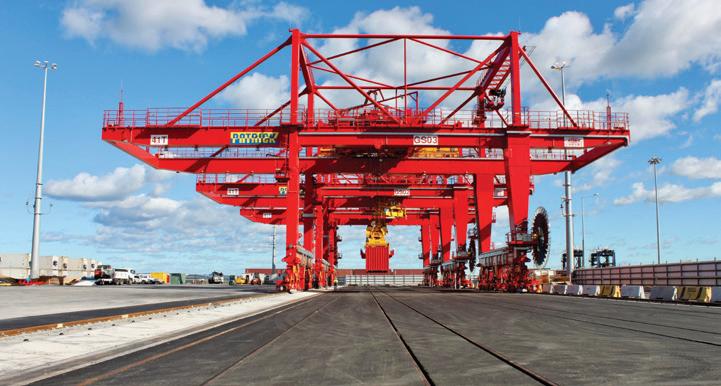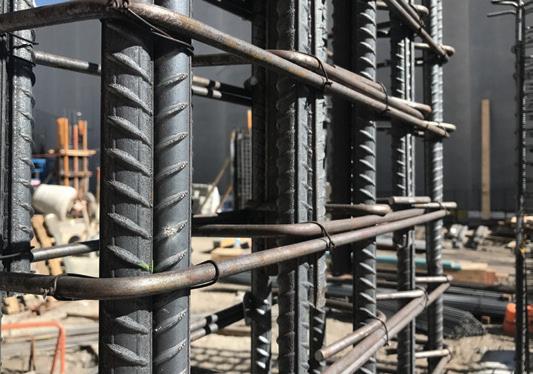
5 minute read
PORT BOTANY ON TRACK TO SUPPORT NSW
by Marika Calfas, CEO, NSW Ports
Australia is an island nation and the state of NSW has the largest population in the country. Connecting NSW and Australia with the global marketplace is the foundation of Port Botany.
Advertisement
Just 40 years ago, the port was built to enable NSW to handle containers – the new form of goods transport at the time. The construction was described at that time as “one of the biggest and most complex engineering projects ever undertaken in NSW”.
Today, Port Botany has cemented its position as Australia’s premier port and is inextricably linked to our lives and our lifestyles. Handling 99 per cent of NSW’s container volume, we rely on Port Botany to import goods for the people and businesses of NSW and to export goods to international customers. In fact, 42 per cent of all goods in a Sydney household have been imported in a container through Port Botany – everything from food, beverages, footwear and floor coverings, to mattresses, paints, fridges, televisions and toys. Port Botany also has Australia’s largest common user bulk liquids facility, handling fuel and gas.
PLANNING FOR NSW’S GROWING TRADE VOLUMES
In 2019 Port Botany handled 2.6M Twenty Foot Equivalent Units (TEUs) 1 and has the highest volume of containers transported by rail of all ports in the country at 440,000 TEUs per year. NSW Government forecasts estimate that Port Botany could be handling over 7.3 million TEUs by 2056.
Our 30 Year Masterplan sets out how the port can handle these growing trade volumes. The key areas of focus include: ensuring efficient road and rail connectivity to our ports and intermodal terminals; growing the use of rail to transport containers; optimising the use of existing land and infrastructure assets; and protecting the ports from urban encroachment.
The use of data and technology will be fundamental to managing port assets. Whilst there has been considerable investment in port infrastructure over the last 40 years, there will need to be continued investment going forward.
In the next 40 years, NSW’s population is forecast to grow to 12.5 million, which includes an extra 3.8 million people living in Greater Sydney alone. Ensuring our port supply chains are able to efficiently cater for the growing trade needs to support this population growth is crucial to the economic vitality of the state.
INVESTING IN RAIL INFRASTRUCTURE
Rail is a fundamental part of our strategy to sustainably support container growth. While Port Botany is already directly connected to a network of Sydney metropolitan intermodal terminals and has dedicated freight rail lines into each of its three container terminals, we continue to invest in growing rail capacity to ensure efficient rail connections, which will keep supply chain costs low and reduce the cost of goods to families and businesses while keeping our exports competitive.
Our long-term goal is to move three million TEUs per year by rail, which will be about 40 per cent of future forecast container volumes. We therefore have a significant program of works underway to help us achieve this goal. This is supported by rail infrastructure investment by government and port and logistics operators. Some of the key projects include:
Port Botany on-dock rail
As the only port in the nation with on-dock rail at all three of its container terminals, Port Botany creates efficiencies and saves money for importers and exporters by removing the need for double handling of containers by trucks.
Together with the stevedores, we are investing in a staged program to increase ‘on-dock’ rail capacity to deliver a total of three million TEU rail capacity at the port.
The first stage involves $190 million investment at Patrick Terminals – Sydney AutoStrad, with $120 million from NSW Ports to deliver on-dock rail infrastructure and $70 million from Patrick Terminals to deliver automated rail operating equipment. The project commenced in 2019 and when it is complete in 2023 it will double the existing Port Botany rail capacity to 1.5 million TEU.
The project will deliver significant benefits for importers and exporters, with 33 per cent faster train turnaround times and increased rail windows. Investment will follow at DP World Australia and Hutchison Ports Australia when the stevedores are ready to invest with NSW Ports.
Using rail, together with trucks, to move containerised freight will also reduce the growth of trucks on Sydney’s road network. For every one million TEUs moved by rail, the number of trucks around the port are reduced by 900 trucks per day.
Connectivity to intermodal terminals
Given 80 per cent of containers moving through Port Botany are delivered to locations within a 40km radius of the port, port rail shuttles are essential to help move more of the freight task to and from Western and South Western Sydney freight precincts. They also help reduce truck growth on Sydney’s roads.
For this reason, we are investing $250 million to develop the Enfield Intermodal Logistics Centre, including an intermodal terminal and logistics warehouses, connected by dedicated freight rail to Port Botany. The intermodal terminal,

operated by LINX Cargo Care, and seven warehouses are now fully operational, with other warehouse precincts currently under construction. Enfield, together with other intermodal terminals such as Moorebank, provide logistics hubs for servicing Greater Sydney’s need for import goods and connecting regional areas.
Port Botany Freight Line Duplication
The Australian Rail Track Corporation’s (ARTC) $400 million project to complete the duplication of the Port Botany rail freight line (2.9km) and construct a new passing loop at Cabramatta on the dedicated freight line will further support increased volumes of containers being moved by rail to and from Port Botany.
Now in the final stages of planning approvals, the project is funded by the Australian Government and should be progressed as a priority to deliver longterm port supply chain benefits.
The project will increase the resilience of the freight rail network and provide the capacity required to meet the forecast rail demand generated by the supply chain activities of regional NSW and existing metropolitan intermodal terminals, including Enfield Intermodal Terminal and Moorebank Intermodal Terminal, and future intermodal terminals in Western Sydney.
A SUSTAINABLE FUTURE
Looking to the future, sustainable operations and sustainable growth continue to be at the forefront of our approach to managing our port and intermodal assets. With ongoing investment in supply chain efficiency, sustainability, and a continued focus on optimising port and terminal capacity, Port Botany will be well equipped to support the state’s growing needs for the next 40 years and beyond.
For more information on NSW Ports and rail connections to and from Port Botany, visit nswports.com.au.










